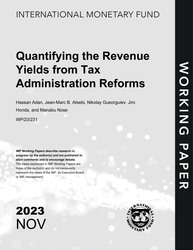
Quantifying the Revenue Yields from Tax Administration Reforms
Quantifying the Revenue Yields from Tax Administration Reforms
READ MORE...
Volume/Issue:
Volume 2023
Issue 231
Publication date: November 2023
ISBN: 9798400258923
$20.00
Add to Cart by clicking price of the language and format you'd like to purchase
Available Languages and Formats
| English |
Prices in red indicate formats that are not yet available but are forthcoming.
Topics covered in this book
This title contains information about the following subjects.
Click on a subject if you would like to see other titles with the same subjects.
Economics- Macroeconomics , Public Finance , Taxation - General , Economics / General , Tax Revenues Yields , Tax Administration , ISORA , TADAT , TA reform , TA reform episodes dataset , revenue yield , TA strength , IMF FAD Tax Administration , Tax administration core functions , International Survey on Revenue Administration (ISORA) , Tax Administration Diagnostic and Assessment Tool (TADAT) , Social security contributions , Global , Middle East , East Asia , North Africa , Central Asia
Also of interest
Summary
Despite the criticality of tax administration (TA) reforms in enhancing domestic revenue mobilization, few studies have attempted to quantify the revenue impact of such reforms. This paper fills this gap by estimating the revenue yields associated with various tax administration capabilities, based on the International Survey on Tax Administration (ISORA), the Tax Administration Diagnostic Assessment Tool (TADAT), and TA reform episodes datasets (identified by Akitoby et al., 2020). It uses a Hausman-Taylor cross-country panel regression and an event study for specific TA reform episodes. Our results (using the ISORA data) show that an increase in the overall strength of TA from the 40th percentile to the 60th percentile is associated with an increase in tax revenue by 1.8 pp. of GDP (with a 95 percent confidence range of 0.5‒2.6 pp. of GDP). Similarly, the event-study assessment shows that sustained TA reforms led to an increase in tax revenues between 2 to 3 pp. of GDP, in line with the experience in three country cases (Jamaica, Rwanda, and Senegal). Also, the revenue yields are increasing over time to more than 3 pp. of GDP after the 6th year following a comprehensive reform. The analysis also highlights the significant impact of specific measures including: i) strengthening compliance risks management, ii) enhancing public accountability, iii) establishing Large Taxpayer Offices (LTO), iv) strengthening accountability and transparency, and v) enhancing timely filing of tax declarations.
Copyright © 2010 - 2025
Powered by:
AIDC



